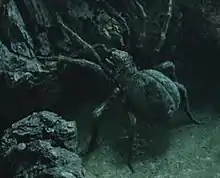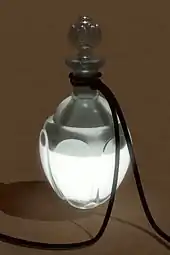Shelob
Shelob is a fictional demon in the form of a giant spider from J. R. R. Tolkien's The Lord of the Rings. Her lair lies in Cirith Ungol ("the pass of the spider") leading into Mordor. Gollum deliberately leads Frodo Baggins there in hopes of recovering the One Ring when Shelob attacks Frodo. The plan is foiled when Samwise Gamgee greatly injures Shelob with Frodo's Elvish dagger, Sting, and the Phial of Galadriel.
| Shelob | |
|---|---|
| Tolkien character | |
| In-universe information | |
| Race | Spider |
| Book(s) | The Two Towers (1954) |
Fictional history
Shelob was an "evil thing in spider-form...[the] last child of Ungoliant to trouble the unhappy world",[T 1] living high in the Ephel Dúath mountains on the borders of Mordor. Although she resided in Mordor and was unrepentantly evil, she was independent of Sauron and his influence. Her exact size is not stated, but she is significantly larger than her descendants, the Great Spiders of Mirkwood, and her hobbit opponents. Unlike ordinary spiders, she uses a stinger instead of chelicerae to inject her venom and paralyze her victims. Her hide is tough enough to resist sword-strokes, and the strings of her webs are likewise resilient to ordinary blades, though the magical Sting manages to cut them. Her main weak point is her eyes, which can be easily harmed or blinded.[1][T 1][T 2]
She is introduced as both evil and ancient: "But still she was there, who was there before Sauron, and before the first stone of Barad-dûr; and she served none but herself, drinking the blood of Elves and Men, bloated and grown fat with endless brooding on her feasts, weaving webs of shadow; for all living things were her food, and her vomit darkness". Her descendants include the Giant Spiders of Mirkwood defeated by Bilbo Baggins in The Hobbit.[T 1]
Shelob's lair was Torech Ungol, below Cirith Ungol ("Pass of the Spider"), along the path that Frodo Baggins and Sam Gamgee took into Mordor, where Shelob had encountered Gollum during his previous trip to Mordor, and he apparently worshipped her. The Orcs of the Tower of Cirith Ungol called her "Shelob the Great" and "Her Ladyship", and referred to Gollum as "Her Sneak". Sauron was aware of her existence, but left her alone as a useful guard on the pass, and occasionally fed prisoners to her. In the story, Gollum led the Hobbits into her lair, planning to recover the One Ring once she had consumed the hobbits. She cornered them; but Frodo used the Phial of Galadriel's light to drive her off, and used Sting to cut the webs blocking the tunnel. Gollum waylaid the pair and tried to strangle Sam, while Shelob paralysed Frodo; but Sam fought off Gollum and then wielded Sting against Shelob. Seeking to crush Sam, she instead impaled herself upon Sting; and, being evil, was nearly blinded by the Phial of Galadriel, containing pure light from the Silmarils; whereupon she fled. Thinking Frodo dead, Sam took the Ring from his friend and left his body behind, but discovered by listening to a pair of Orcs that Frodo was alive but senseless, under a minor influence of venom.[T 1]
Name
As Tolkien admitted in a letter to his son, Shelob "is of course only 'she + lob'", lob being an archaic English word for spider, influenced by Old English loppe or "spider". The word is not related to "cob" nor "cobweb".[T 3] Old English attercoppe (meaning "spider") is derived from atter meaning "poison" and coppe meaning "head"; the OE term is a loan from Old Norse language and survives in modern Danish as edderkop, spider. Tolkien used "attercop" as well as "cob" and "lob" in The Hobbit, where Bilbo Baggins sings songs taunting the giant spiders in Mirkwood: "Attercop, Attercop, Old Tomnoddy" and "Lazy Lob and Crazy Cob".[T 4]
Reception
Critics such as Alison Milbank have observed that while there are few significant female characters in Lord of the Rings, Shelob is undeniably sexual. Milbank comments that "Tolkien offers a most convincing Freudian vagina dentata (toothed vagina) in the ancient and disgustingly gustatory spider Shelob."[2]
Milbank notes further that Shelob symbolises "an ancient maternal power that swallows up masculine identity and autonomy", threatening a "castrating hold [which] is precisely what the sexual fetishist fears, and seeks to control".[2] Milbank comments that it is fitting that another ancient female character, the elf-queen Galadriel, who both chooses not to be the "She-who-must-be-obeyed" by renouncing the One Ring that Frodo offers her, and gives Frodo her light (the Phial of Galadriel) with which the hobbits will defeat Shelob.[2] The critic Jane Chance Nitzsche mentions "[the hobbit] Sam's penetration of her belly with his sword", noting that this may be an appropriate and symbolic way of ending her production of "bastards".[3]
Nitzsche spends more time, however, comparing Shelob with the wizard Saruman, noting that both are "monsters" that live in towers; they have similarly-structured books in Lord of the Rings, one ending in a military attack on Saruman's tower, Orthanc; the other, in the hobbits' venturing into Shelob's lair in Cirith Ungol. Further, she writes, while Saruman has a "perversion of mind", Shelob has a "perversion of body".[3] Nitzsche stresses Shelob's "gluttony", consisting of an "insatiable appetite", laziness, since the Orcs bring her food, and "lechery" with her many bastard offspring. Nitzsche draws a different comparison, with the guardian of the gateway to Hell, noting that in John Milton's Paradise Lost, Satan mated with his daughter, Sin, their offspring being Death, constantly randy for his mother: but Tolkien in one place describes Shelob as Sauron's cat rather than his daughter.[3]
The critic Joyce Tally Lionarons writes that Tolkien constructs the elves and the spiders such as Shelob as polar opposites, the elves good and bright, the spiders evil and dark.[4]
Adaptations

In the 1981 BBC Radio adaption of The Lord of the Rings, Shelob is portrayed by BBC Radiophonic Workshop member Jenny Lee via a series of treated vocal effects. As part of the technical crew Lee had contributed sound effects elsewhere in the series, but received an acting credit for her work on Shelob.[6]
In Peter Jackson's film trilogy, Shelob's appearance is delayed until the middle of the third movie, The Lord of the Rings: The Return of the King, wherein Shelob has a retractable venomous wasp-like stinger between the spinnerets, which she uses to paralyze Frodo. She also appears to have a gaping mouth, equipped with four chelicerae and two fangs. Of her eyes, only four are visible. In a DVD commentary, Jackson says Shelob's appearance is mostly based on the New Zealand tunnel-web spider, which he hates.[5]
In the video game The Return of the King, based on the film, Shelob is one of the bosses and her defeat is required to beat the level "Shelob's Lair". In The Lord of the Rings: The Battle for Middle-earth II, Shelob is a hireable hero-unit of the Goblin faction.
In the video game Lego The Lord of the Rings, she is the enemy of the level The Secret Stairs, briefly, as Frodo and Gollum run away from her. She then appears at the start of the next level, Cirith Ungol, wherein the player(s) can use the characters of Samwise Gamgee or the Orc, Shagrat.
Shelob is a major character in the video game Middle-earth: Shadow of War, where she serves as both the narrator and an ally to player character Talion. In the game, Shelob uses shape-shifting ability to assume the form of an attractive human woman. Following criticism of this decision, creative director Michael de Plater explained his interpretation that Gollum and Shelob were "the unsung heroes of The Lord of the Rings", with Shelob sensing Frodo's weakness and making a pact with Gollum to hasten him to Mount Doom and the confrontation that destroys the ring. De Plater envisioned Shelob as a dark counterpart to Galadriel, noting how both manipulate lesser beings, but that Shelob is more honest.[7]
See also
- Lord of the Rings
- Middle-earth peoples
References
Primary
- This list identifies each item's location in Tolkien's writings.
- The Two Towers, book 4, chapter 9: "Shelob's Lair."
- The Two Towers, book 4, chapter 8: "The Stairs of Cirith Ungol"
- The Letters of J.R.R. Tolkien, 81 (#70)
- The Hobbit, chapter "Flies and Spiders". The full poem
Secondary
- Thomson, George H. (1967). ""The Lord of the Rings": The Novel as Traditional Romance". Wisconsin Studies in Contemporary Literature. Wisconsin Studies in Contemporary Literature. 8 (1): 43–59. doi:10.2307/1207129. JSTOR 1207129.
- Bassham, Gregory; Bronson, Eric (2013). The Lord of the Rings and Philosophy: One Book to Rule Them All. Open Court. p. 35. ISBN 978-0-8126-9806-0.
- Nitzsche, Jane Chance (1980) [1979]. Tolkien's Art. Papermac. pp. 111–113. ISBN 0-333-29034-8.
- Lionarons, Joyce Tally (2013). "Of Spiders and Elves". Mythlore. 31 (3): 5–13.
- Bonin, Liane (19 December 2003). "The secrets of LOTR's eight-legged villain". EW.com.
- Pearse, Edward (15 January 2009). "The Lord of the Rings, Episode 2". Radio Riel.
- Chiodini, Johnny (15 August 2017). "Why Shelob is a woman in Shadow of War". Eurogamer. Retrieved 15 August 2017.

.jpg.webp)